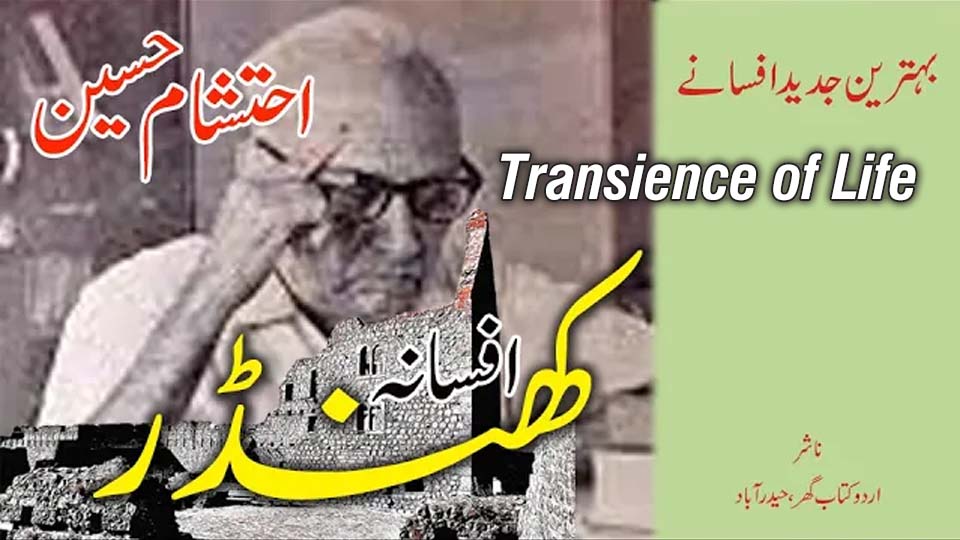Transience of life in Urdu short stories is a recurring theme that captures the fleeting nature of human existence. From crumbling ruins to silent, forgotten characters, Urdu literature has masterfully used symbolism and allegory to reflect on life’s impermanence. Among these, the short story “Khandar” (The Ruins) by Syed Ehtesham Hussain stands as a hauntingly beautiful example that compels readers to confront the brutal reality of time, decay, and isolation.
The Power of Allegory in Depicting Transience
In “Khandar”, the transience of life in Urdu short stories finds expression through a decaying structure, a dying beggar, a barren tree, and a motionless vulture. Each element acts not just as a background detail but as a living symbol. The deserted building, once glorious, now shelters a frail man who survives by begging all day and returns only to collapse in solitude. The presence of the vulture, ominously waiting, transforms into a symbol of death lurking near.
The story does not dramatize events. Rather, it lets the silence speak. The transience of life in Urdu short stories like this doesn’t shout—it echoes quietly and lingers painfully.
A Story of Decay, Isolation, and the Inevitable End
As the beggar grows weaker, unable to seek food or move, he lies dying in the very ruins that once sheltered him. The dry banyan tree above him remains his only companion—until the vulture descends. In his final moments, the story reaches its symbolic climax: the transformation of man into prey. This is not merely a death scene; it is a powerful allegory of how society watches the vulnerable decline in silence until even nature takes over.
Through this, Syed Ehtesham Hussain evokes both pity and reflection. The story becomes a mirror, not just of the character’s life, but of our shared human condition.
Syed Ehtesham Hussain: Beyond a Storyteller
Syed Ehtesham Hussain was not only a short story writer but also a Marxist critic, translator, and poet. He believed literature should awaken social consciousness. His work rejects escapism; instead, it demands awareness. His collection “Viraane” (The Wastelands), published in 1943, brought stories like Khandar into the limelight. These tales didn’t rely on melodrama but focused on social decay, class struggle, and human helplessness, all seen through a literary lens.
In each narrative, the transience of life in Urdu short stories became not just a background theme, but a philosophical stance.
Why This Theme Resonates Today
In today’s world of noise, distraction, and fast-paced living, stories like Khandar forces a pause. They whisper truths we often ignore: nothing lasts forever, and loneliness is the echo of forgotten lives. This relevance keeps the theme of life’s transience alive and significant in Urdu short stories. It resonates with anyone who has experienced loss, disconnection, or the slow erosion of hope.
Such stories remind us that literature isn’t just for enjoyment—it’s a vessel for truth, no matter how uncomfortable.
Final Reflections: The Timeless Echo of Impermanence
The transience of life in Urdu short stories like Khandar leaves readers with more than just emotional weight—it offers a space to reflect on mortality, decay, and the subtle cruelty of time. These are stories that grow quieter with age, yet more meaningful. They linger not because of loud action, but because of the silence that surrounds their characters.
In Syed Ehtesham Hussain’s literary world, impermanence is not just an idea—it’s a living character, always present, always watching.
If you’re interested in reading this book, click the link below for a free download.
https://drive.google.com/file/d/1jfk8NKXFCurKQk8p4Xra2DnGYswOaS2n/view?usp=sharing
If you’d like to listen to this book in audio format, click the CONTACT button below to get in touch with the AwazeUrdu team to order the audiobook.
You can also watch the same video on these social media platforms.
Have you read similar stories that explore life’s fleeting nature? Share your thoughts or favourite Urdu short stories in the comments. Let’s keep the conversation alive!
اردو افسانے کی دنیا میں تمثیل کو ہمیشہ ایک اہم فنی حربے کے طور پر استعمال کیا گیا ہے۔ تمثیل نہ صرف کسی پیچیدہ حقیقت کو علامتی انداز میں پیش کرنے کا مؤثر ذریعہ ہے، بلکہ یہ قاری کے ذہن میں دیرپا اثرات بھی چھوڑتی ہے۔ سید احتشام حسین کا افسانہ “کھنڈر” اس کی عمدہ مثال ہے، جس میں زندگی کی بےثباتی، انسانی زوال، اور تنہائی کو تمثیلی انداز میں اس خوبی سے پیش کیا گیا ہے کہ قاری کہانی کے پس منظر میں چھپی حقیقت کو محسوس کرتا ہے، نہ کہ صرف پڑھتا ہے۔
سید احتشام حسین اردو ادب کے ممتاز ترقی پسند نقاد، مترجم، شاعر اور افسانہ نگار تھے۔ ان کا شمار ان ادیبوں میں ہوتا ہے جنہوں نے اردو تنقید میں سائنسی اور مارکسی نظریات کو متعارف کروایا۔ ان کی تحریروں میں سادگی، وضاحت اور فکری گہرائی نمایاں تھی۔ وہ ادب کو محض تفریح کا ذریعہ نہیں بلکہ سماجی شعور اور فکری بیداری کا آلہ سمجھتے تھے۔ ان کی تنقیدی کتابیں جیسے اردو ادب کی تنقیدی تاریخ، تنقیدی جائزے، روایت اور بغاوت، ادب اور سماج وغیرہ اردو تنقید کی کلاسیکی بنیادوں میں شمار ہوتی ہیں۔ وہ الہ آباد یونیورسٹی میں شعبۂ اردو کے صدر بھی رہے اور یکم دسمبر 1972 کو وفات پا گئے۔
افسانے کے میدان میں ان کا پہلا اور نمایاں مجموعہ “ویرانے” ہے، جو 1943 میں شائع ہوا۔ اس مجموعے کی کہانیاں اردو افسانے کو ایک نئی فکری جہت دیتی ہیں۔ ان میں طبقاتی کشمکش، انسانی بےبسی، اور تنہائی جیسے موضوعات کو نہایت سادہ مگر مؤثر انداز میں بیان کیا گیا ہے۔ احتشام حسین نے ان افسانوں میں محض بیانیہ یا جذباتی تاثرات پر انحصار نہیں کیا بلکہ علامتی اور تمثیلی زبان کے ذریعے قاری کو سوچنے پر مجبور کیا ہے۔ ویرانے اردو افسانوی ادب میں ایک سنجیدہ اور فکری کاوش کے طور پر پہچانا جاتا ہے۔
اسی مجموعے کا افسانہ “کھنڈر”اردو افسانے میں تمثیل نگاری کا ایک بہترین نمونہ ہے۔ یہ کہانی ایک ایسی ویران اور شکستہ عمارت کے گرد گھومتی ہے جو بظاہرغیرآباد ہے، مگر درحقیقت ایک بوڑھے بھکاری کی جائے پناہ ہے۔ یہ کھنڈر، سوکھا برگد کا درخت، اور اس پر بیٹھا ہوا ایک گدھ—تینوں مل کر ایک ایسی تمثیل تشکیل دیتے ہیں جو انسانی زندگی کی بےثباتی، تنہائی اور زوال کی عکاسی کرتی ہے۔ کہانی میں بتایا گیا ہے کہ یہ کھنڈر کبھی شاندار عمارت رہا ہوگا، مگر اب اس میں صرف ایک بھکاری رات گزارنے آتا ہے، جو شہر میں دن بھر بھیک مانگتا ہے اور پھر اسی کھنڈر میں پناہ لیتا ہے۔ اس کی ہمراہی صرف وہ برگد کا درخت ہے، جس پر گدھ بیٹھا رہتا ہے—ایک ایسا گدھ جو مردار کا منتظر ہے، اور جو اس بھکاری کی زندگی کے آخری لمحات میں متحرک ہو جاتا ہے۔
جوں جوں بھکاری بوڑھا اور کمزور ہوتا جاتا ہے، اس کی حرکات محدود ہو جاتی ہیں، اور وہ کئی دن بغیر کھائے پیے کھنڈر ہی میں پڑا رہتا ہے۔ آخرکار شدید بخار اور بھوک کی حالت میں وہ گر کر بےجان ہو جاتا ہے۔ جیسے ہی اس کی حرکت ختم ہوتی ہے، وہی ساکت گدھ نیچے اترتا ہے اور مردے پر جھپٹنے کی کوشش کرتا ہے۔ رفتہ رفتہ دوسرے گدھ بھی جمع ہو جاتے ہیں، اور آخرکار وہی بھکاری جو کل تک زندہ انسان تھا، اب مردار بن کر اُن کا شکار بن جاتا ہے۔ یہ منظر صرف ایک انسان کی موت نہیں بلکہ زندگی کی بےرحم حقیقت، سماج کی بےحسی، اور وقت کی بےمروتی کی تمثیل بن جاتا ہے۔ اس افسانے میں کوئی واقعہ زور و شور سے پیش نہیں کیا گیا، بلکہ ہر شے—کھنڈر، بھکاری، درخت، اور گدھ—ایک علامت ہے، اور ان سب کی موجودگی مل کر انسان کی تدریجی زوال پذیری اور فنا کا کربناک نقشہ کھینچتی ہے۔
احتشام حسین کا یہ افسانہ نہ صرف فنی اعتبار سے ایک کامیاب تمثیل ہے بلکہ فکری لحاظ سے بھی ایک گہرا تاثر چھوڑتا ہے۔ یہ افسانہ ہمیں یاد دلاتا ہے کہ ادب کا اصل مقصد زندگی کی سچائیوں کو بیان کرنا اور انسانی شعور کو بیدار کرنا ہے۔ احتشام حسین نے اپنی تنقید کی طرح افسانے میں بھی یہی فریضہ انجام دیا اور اردو ادب کو ایک نیا شعور دیا، جو آج بھی زندہ اور مؤثر ہے۔

